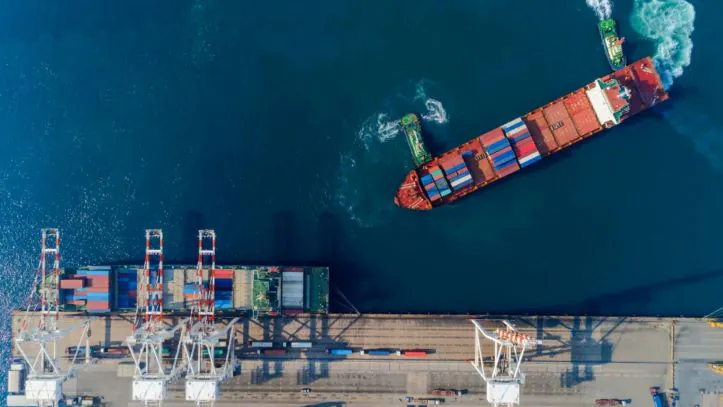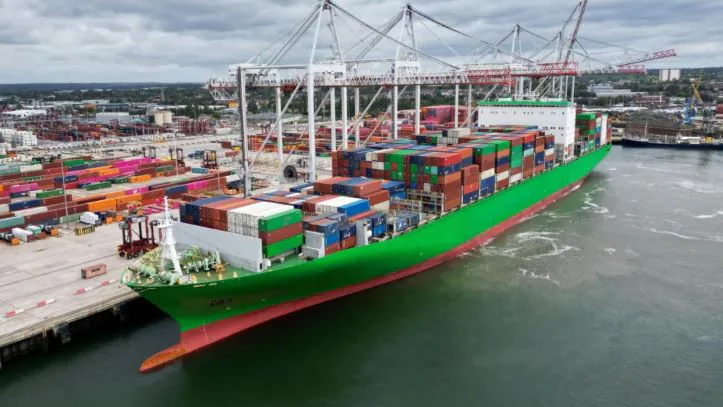How Does the Weight of a Shipping Container Affect the Cost?
Learn how to manage a container’s weight, avoid costly errors, and optimize shipping logistics. Container weight significantly impacts shipping costs and compliance. This guide explores efficient load planning and regulatory requirements using EasyCargo.

Transporting cargo involves costs based on weight. Shipping fees are heavily influenced by tonnage, making proper weight assessment crucial for sea freight. Incorrect weight estimation can lead to container rejections at ports, logistical inefficiencies, and financial losses.
Shipping companies, such as MAERSK and Hapag-Lloyd, provide container specifications to help businesses select suitable containers. However, correct weight distribution remains a key challenge at warehouse docks. Poor container load planning affects not just space utilization but also the overall weight management of shipments.
In 2023, the European Union’s shipping container area presented a diverse picture that led to growth in container shipping, where gross tonnage increased by nearly 1 million to 17,461,237. In 2023, the average size of vessels calling at the main EU ports increased by 5.2% to slightly more than 8,000 GT compared to the previous year. Looking at the decade since 2013, most countries experienced substantial growth, notably Poland, Croatia, and Spain, though Latvia and Finland saw decreases. This data’s contrasting trends highlight the dynamic shifts impacting the EU and its neighboring countries, as well as the importance of container weight, which affects global statistics and presents economic influence.
Container weight and compliance
The task of loading containers is not just a matter of choice for the carriers but also a big task for companies. For example, according to the latest issue of ISO 668, 20′ containers should have a maximum weight of about 24,000 kg (52,910 lbs). This gives us a clear follow-up on the process of loading and how the weight of containers is handled. This ensures that not only is cargo able to be loaded onto the ships, but also ensures compliance.

Before a container is loaded onto a cargo ship, its weight must be verified. If a container was previously weighed at another port, it can be transshipped without re-weighing, provided the terminal has been notified.
Different freight service providers may implement different weight verification procedures. These typically include two methods:
- Weighing the fully packed container
- Adding up the entire weight of the cargo and contents and comparing it to the tare weight of the container as indicated on its door
Accurate weight assessment for export containers is critical, and failure to provide or incorrectly estimate this information can lead to significant repercussions. Here’s a breakdown of potential issues:
- Liability and Responsibility: The shipper named on the ocean carrier’s bill of lading is solely responsible for providing the container’s Verified Gross Mass (VGM), even for co-loaded containers. “Master” forwarders cannot rely on weight declarations from co-loading forwarders; they must ensure accurate verification.
- Compliance and Legal Issues: Shipping documents must be signed by an authorized shipper representative and submitted to the vessel’s master or representative, as mandated by the forwarders’ regulations. Loading a container without a VGM violates ISO and carrier regulations.
- Operational Delays and Costs: The lack of a VGM can necessitate on-site weighing at the port, potentially causing delays. If the terminal lacks weighing equipment, alternative (possibly more costly) methods must be used, or the container will be refused for loading.
- Terminal and Carrier Procedures: Marine terminals must establish procedures for obtaining the weights of containers lacking VGM. Terminals and carriers must agree on handling such situations, which can lead to complications and delays in the shipping process.
Vessel Stowage and Safety: Verified weights are essential for accurate vessel stow planning, ensuring ship stability and safety. Using unverified or incorrect weights can compromise vessel integrity and pose safety risks.

What is VGM (Verified Gross Mass)?
The Verified Gross Mass (VGM) requirement exists to safeguard maritime operations. It mandates that shippers supply precise container weights to carriers, thereby preventing accidents caused by inaccurate weight declarations, which have historically led to significant safety hazards.
The Verified Gross Mass (VGM) is a mandatory requirement for maritime safety, ensuring accurate container weight declarations.
- Purpose: Prevents accidents caused by inaccurate weights.
- Requirement: The Shipper provides the container’s total weight (cargo, packaging, tare) with a signed confirmation.
- Implementation: Required by all IMO member countries.
- Methods: Weigh the packed container, or weigh the contents and add the tare weight.
- Responsibility: Shipper on the Bill of Lading.

Who is responsible for the container weight?
Oversized vehicles, particularly those carrying intermodal containers, seriously threaten road safety. Excess weight decreases stopping distances, destabilizes vehicles, and speeds up road degradation. In addition, inconsistent weight verification practices, such as overweighing and conflicting records, cause unnecessary confusion and make it difficult for drivers to comply with basic safety regulations.
Below, we share a shortlist of entities and personnel that are responsible for container weight:
Consignor (Shipper/Importer/Forwarder): They are responsible for creating a compliant container weight declaration (electronic or printed) and must always provide this declaration to the road transport operator or driver before the container’s journey.
Drivers: Drivers must be prohibited from driving a vehicle carrying a container without a compliant weight declaration. They must always keep a copy of the declaration with the container during transport.
Operators (Transport Arrangers): This person must ensure drivers receive the necessary weight declaration before transport commences. If the container is transferred to another carrier (road or rail), the operator must provide the declaration to that subsequent carrier.
Consignee (Receiver): They must not encourage or incentivize weight, dimensions, or load restraint regulation violations. Consignees are considered complicit if they were aware or should have reasonably known that:
- A proper container weight declaration was not supplied.
- The weight or content information in the declaration was false or misleading.

Maximum weight for a 40-foot container
Assessing the weight of 40-foot containers depends on the cargo carriers. The 40 ft. High Cube general-purpose container is a versatile solution for transporting various types of cargo, offering a balance of lightweight construction and ample volume. Key features to consider include:
- Optimal Dimensions: It is designed for overweight cargo up to 2.70 m, and its internal dimensions provide ample space (12,024 mm length, 2,350 mm width, 2,697 mm height).
- Robust Lashing: Equipped with numerous lashing devices along the top and bottom longitudinal rails and corner posts, each with a permissible load of 1,000 kg, ensuring secure cargo fastening.
- Weight Considerations: It’s crucial to adhere to permissible weight limits for road and rail transport and be aware of potential overheight restrictions for inland transportation.
- Capacity and Construction: The container, constructed with corrugated steel walls and a wooden floor, offers a payload capacity of 26,460kg and a volume of 76.3 m³.
20-foot cargo container weight
The 20′ cargo container is specialized for handling heavy and oversized cargo. It offers unique loading capabilities that need to be considered:
- Heavy and High Loads: This container is designed for transporting dense and tall items. Its removable steel roof allows for crane loading.
- Flexible Loading: Removable roof and swing-out door header facilitate easy crane loading, while roof sections can be secured inside for overheight cargo.
- Enhanced Floor Strength: Reinforced floor supports forklift operations with a capacity exceeding ISO standards.
- Secure Lashing: Equipped with numerous lashing points, including high-capacity corner and rail devices, ensuring cargo stability.
- Weight Considerations: Warehouses are built for heavy loads, but they must adhere to land transport weight restrictions. The maximum payload can only be used if distributed over the total floor area.
Weight of the container: load planning
Efficient container loading is a critical aspect of logistics, impacting both safety and cost-effectiveness. Inaccurate weight distribution and inefficient cargo placement can lead to significant issues, including road safety hazards, increased transportation costs, and delays.
Here’s how such a platform assists in planning container load and weight:
Efficient Load Planning
- Allows for quickly inputting cargo dimensions, weight, and other specifications, generating optimized 3D load plans within seconds.
- Considers weight limits and loading constraints like non-stackable items.
- Users can define and adjust cargo spaces, enabling precise planning for various container types.
Accurate Weight Management
- Verifies weight distribution compliance to prevent overloading.
- Reduces errors from manual calculations.
Improved Visualization and Control
- The interactive 3D visualization allows for a detailed examination of the load plan, enabling users to identify weight distribution issues.
- The manual load plan editor provides granular control over cargo placement and orientation, ensuring optimal loading and stability.

Summary
Accurate container weight management is critical in the global shipping industry. It affects both safety and economic efficiency. This report highlights the critical importance of compliance with verified gross weight (VGM), legal obligations, and the potential consequences of inaccurate weight declarations. Thus, moving from shipper responsibilities to driver operational requirements, there is no doubt that every stakeholder plays an important role in ensuring the safe and compliant transportation of containers.
Companies must prioritize accurate weighing to ensure smooth and compliant shipping operations. They should verify this part of the business and leverage advanced load planning tools. It’s worth implementing rigorous VGM verification processes and investing in shipment planning software such as EasyCargo. Consider how to optimize container loading and prevent costly delays and safety risks. Contact us or schedule a free consultation.




